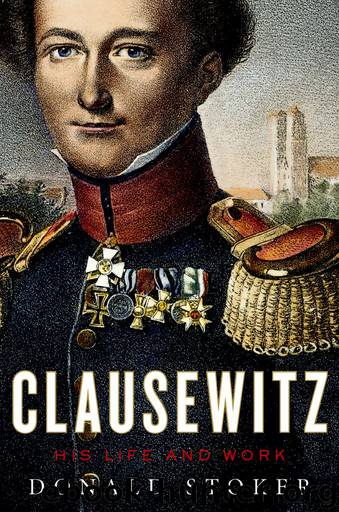Clausewitz by Donald Stoker

Author:Donald Stoker
Language: eng
Format: epub
Publisher: Oxford University Press, Incorporated
Published: 2014-04-15T00:00:00+00:00
Map 8.2. Clausewitz’s War in North Germany.
To prepare for the renewal of hostilities, Wallmoden anchored his lines in the north at Ratzenburger, on the lake. He spread his cavalry and some supporting units over the center region along the Stecknitz River at such hamlets as Mölln and Büchen and put the bulk of his infantry in the defenses of Lauenberg, south of Büchen. The Stecknitz formed his first line of defense, but troops held other cities, including Boitzenburg to the east of Lauenberg, Dömitz on the banks of the Elbe, Wittenburg, and Hangenow (where Wallmoden established his headquarters).34
Wallmoden had orders to go on the offensive when the war began, but the French didn’t give him the chance. Napoleon had ordered Davout to march against Berlin in support of Oudinot’s drive. Davout, with the Danes, had around 40,000 men. Wallmoden had roughly 22,000—spread over a large tract of northern Germany—when the campaign opened. On August 17 the Allies spotted a column advancing against the entrenchments at Lauenberg. Davout hit the city hard the next day; it fell quickly. The same day—the 18th—Wallmoden’s forces also abandoned Büchen under French pressure.35
“We didn’t counterattack the post,” Clausewitz wrote to Marie of Lauenberg a few days later, “because it is not our intention to fight on the Stecknitz.” He also told her that they had captured a note from Napoleon to Davout in which Napoleon told his marshal to not let himself be deterred “by rabble like Wallmoden’s Hanseatic troops.” Clausewitz obviously thought more of their force, and had quickly grown to like the personality of his new commander. “Under the guise of a complete world-weariness glows a noble fire,” he told Marie on August 20, and soon found their working relationship an enjoyable one, although he reserved judging Wallmoden’s skills as a soldier until he had seen a bit more of him.36
They did not fight on the Stecknitz as Clausewitz told Marie, and Davout was not in the least deterred. After overrunning their posts on the Stecknitz, Davout jumped the river and advanced in three columns. His northern column (his left wing) took the road to Cammin on the Schaale River and Wittenburg, north of Goldenbow, the two others aimed at the area of Goldenbow-Vellahn. A few miles west of his base at Hagenow, at Cammin and on the heights stretching north-south from there to the hamlets of Goldenbow and Vellahn, Wallmoden placed the bulk of the Russo-German Legion and some other forces in support. His cavalry watched the plains, the woods and marshes of the Elbe anchored his southern flank. In all, he had about 9,000 men. Davout slammed into Wallmoden’s men at around five in the afternoon of August 21 with 16,000–18,000 men. The Russo-German Legion and other units fought off the French at Vellahn until nightfall, then withdrew to the forests on the nearby rivulet of Schaal. Davout took Cammin at 9:00 p.m. Wallmoden withdrew to Hagenow on August 22.37
Davout kept up the pressure. On the afternoon of August 23 he
Download
This site does not store any files on its server. We only index and link to content provided by other sites. Please contact the content providers to delete copyright contents if any and email us, we'll remove relevant links or contents immediately.
| Africa | Asia |
| Canadian | Europe |
| Holocaust | Latin America |
| Middle East | United States |
Fanny Burney by Claire Harman(26526)
Empire of the Sikhs by Patwant Singh(22974)
Out of India by Michael Foss(16791)
Leonardo da Vinci by Walter Isaacson(13182)
Small Great Things by Jodi Picoult(7019)
The Six Wives Of Henry VIII (WOMEN IN HISTORY) by Fraser Antonia(5396)
The Wind in My Hair by Masih Alinejad(5034)
A Higher Loyalty: Truth, Lies, and Leadership by James Comey(4845)
The Lonely City by Olivia Laing(4750)
The Crown by Robert Lacey(4723)
Millionaire: The Philanderer, Gambler, and Duelist Who Invented Modern Finance by Janet Gleeson(4376)
The Iron Duke by The Iron Duke(4292)
Papillon (English) by Henri Charrière(4195)
Sticky Fingers by Joe Hagan(4101)
Joan of Arc by Mary Gordon(4014)
Alive: The Story of the Andes Survivors by Piers Paul Read(3969)
Stalin by Stephen Kotkin(3875)
Aleister Crowley: The Biography by Tobias Churton(3589)
Ants Among Elephants by Sujatha Gidla(3417)
